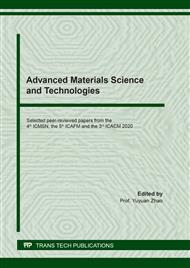p.3
p.9
p.15
p.23
p.31
p.41
p.49
p.56
Effect of Keratin Extracted from Chicken Feather Filled Electrospun Polyacrylonitrile Nanocomposite Membrane
Abstract:
Chicken feathers are known for its unique properties such as low density, warmth retention, and distinct morphological structure [1]. Despite these unique properties, chicken feathers are considered a waste byproduct of the poultry industry [2]. To utilize feather waste, it was used as an additive to reinforce Polyacrylonitrile (PAN) polymer in the form of Keratin Extract. The highlight of the study is to prepare and characterize PAN with chicken feather keratin as additive by electrospinning. Keratin was extracted under reduction method with the use of sodium sulphide and solubilized with NaOH [3]. The presence of Keratin was confirmed with Fourier Transform Infrared Microscopy (FTIR) and Ultraviolet–visible Spectroscopy (UV-Vis).PAN nanofibers with different keratin loadings were formed by electrospinning process and Dimethylformamide (DMF) as solvent. The electrospun nanocomposite membranes were analyzed using Scanning Electron Microscopy (SEM), FTIR, contact angle goniometer, and Ion-Adsorption test. Addition of keratin into the polymer solution, decreased the average fiber diameter from 91nm (Pure Keratin), 84nm (PAN/1%Keratin), 71nm (PAN/3%Keratin) to aggregates (PAN/5%Keratin). Also, the change in morphology affected the polymer’s hydrophilicity. As the percentage loading of keratin increases, the average contact angle decreases. The average contact angle of Pure Pan, 1%, 3%, and 5% keratin decreased from 28.21°, 18.85°, 16,76° to 15.34°. The effect of the fiber on conductivity was also tested with a salt bath method. 3M of NaCl solution presented a conductivity of 93.0 mS. Upon the addition of Pure PAN in saltwater Solution, the conductivity had decreased to 60.0mS which indicated that some ions from the NaCl had adhered to the membrane. Upon the addition of Keratin nanofibers, it can be observed that the conductivity increases to 61.0 mS, 96.8 mS. and 100.1 mS as the percentage of keratin loading increases.
Info:
Periodical:
Pages:
9-14
Citation:
Online since:
March 2021
Keywords:
Price:
Сopyright:
© 2021 Trans Tech Publications Ltd. All Rights Reserved
Share:
Citation:


